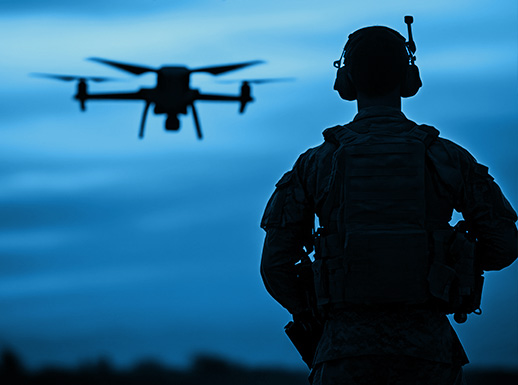
ISR (Intelligence, Surveillance, and Reconnaissance)
Cutting-edge components built for uncompromised intelligence
The domain of Intelligence, Surveillance, and Reconnaissance (ISR) involves gathering intelligence across various platforms, including drones (UAS/UAVs), satellites, radar systems, and manned aircraft. These high-tech platforms carry advanced sensor suites such as high-resolution cameras, synthetic aperture radar (SAR), electronic intelligence (ELINT), and thermal imaging. The components within these sensor suite systems must meet stringent SWaP requirements while enduring the extreme thermal cycling, vibration, and radiation.
Electronic components designed for ISR applications must be able to provide stable, clean power and maintain noise-free signal paths for accurate, real-time data transmission.
Guaranteeing data purity from sensor to ground operation
AEM's technology is instrumental in the power management and noise suppression circuitry essential for accurate intelligence gathering.
Our components protect the sensitive optics and processing electronics while ensuring the high-bandwidth data links remain uncorrupted. RF: Microwave to millimeter wave components are fundamental to Intelligence, Surviellance, and Reconnaissance applications, as all forms of electronic intelligence gathering, radar, and high-speed data transfer rely on transmitting and receiving electromagnetic waves. Meanwhile, high-reliability ferrite chip beads are crucial for filtering, while high-reliability fuses ensure the system stays powered and protected regardless of the operating environment.
- Circulators and Isolators are essential for switching between transmitting and receiving modes on the same antenna. They protect sensitive receiver circuitry from the high-power pulse of the transmitter.
- Filters are used on the transmit and receive paths to ensure the signal is clean, and to reject unwanted out-of-band interference.
- Power amplifiers are used to ensure signals have enough power to reach their destinations over vast distances. These are vital for high-bandwidth data links, radar, and remote sensing systems.
- Low noise amplifiers (LNAs) amplify the faint signal that comes from long-distance sources, maximizing the signal-to-noise ratio (SNR) for effective geolocation and analysis.
- High-reliability beads are critical for suppressing EMI/RFI noise, ensuring maximum data purity and image quality.
- High-reliability fuses are essential for overcurrent protection, power distribution, and meeting SWaP requirements due to their endurance in extreme environments.
